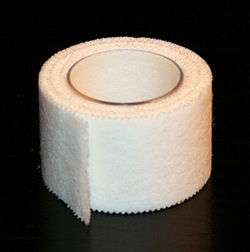Microporous material
A microporous material is a material containing pores with diameters less than 2 nm. Examples of microporous materials include zeolites and metal-organic frameworks.
Porous materials are classified into several kinds by their size. The recommendations of a panel convened by the International Union of Pure and Applied Chemistry (IUPAC) are:[1]
- microporous materials have pore diameters of less than 2 nm.
- mesoporous materials have pore diameters between 2 nm and 50 nm.
- macroporous materials have pore diameters of greater than 50 nm.
Micropores may be defined differently in other contexts. For example, in the context of porous aggregations such as soil, micropores are defined as cavities with sizes less than 30 μm.[2]
Uses in laboratories
Microporous materials are often used in laboratory environments to facilitate contaminant-free exchange of gases. Mold spores, bacteria, and other airborne contaminants will become trapped, while allowing gases to pass through the material. This allows for a sterile environment within the contained area.
Use in medicine

Microporous adhesive tape is a surgical tape used to hold wound dressings and bandages in place, introduced in 1959 by 3M with the trade name Micropore.[3] It can be used to hold gauze padding over small wounds, usually as a temporary measure until a suitable dressing is applied.[4] The Steri-Strip was derived from Microporous surgical tape. However, in this context the term microporous does not refer to a microporous material, but rather to pores small enough to not be "visible with the naked eye".[5]
Other uses
Microporous tape is used by some professional extreme yo-yoers to wrap around their fingers and prevent string burn or irritation.
Rock climbers use microporous tape to wrap their hands in 'tape gloves', a means of protecting the skin from rock abrasion when jamming hands into cracks as a means of ascent (crack climbing, as opposed to face climbing - gripping holds on the face of the rock).
Microporous media used in large format printing applications normally with a pigment based ink to maintain colour balance and life expectancy of the resultant printed image.
Microporous tape is also used by some film and TV sound recordists to affix small radio microphones to actors' skin.
Microporous material is also used as high performance insulation material used from home applications up to metal furnaces requiring material that can withstand more than 1000 Celsius.
See also
- Characterisation of pore space in soil
- Nanoporous materials
- Steri strip
- Dressing (medical)
- Conjugated microporous polymer, a type of microporous material
References
- Rouquerol, J.; et al. (1994). "Recommendations for the characterization of porous solids" (PDF). Pure Appl. Chem. 66: 1739–1758. doi:10.1351/pac199466081739. Retrieved 2015-02-24. See page 1745.
- Soil Science Glossary Terms Committee (2008). Glossary of Soil Science Terms 2008. Madison, WI: Soil Science Society of America. ISBN 978-0-89118-851-3.
- "3M Micropore Surgical Tape". Medicine. 3M Inc. Retrieved 2017-06-19.
- 3M Company (2003). "3M™ Micropore ™ Surgical Tapes - Commonly Asked Questions" (PDF).